
Bouldering for beginners: How to get started
Bouldering has become increasingly popular over the past few years, and the trend continues. No wonder! This sport offers a perfect full-body workout, is a brain sport at the same time, and is also a great deal of fun – not to mention the cool community. You also want to try out climbing, but are still a beginner when it comes to bouldering?
Nick from urban apes explains to us what equipment you need for bouldering, as well as the basics and tips for indoor climbing. On top of that, professional rock climber Stephan Vogt tells us what makes bouldering so special for him.
Bouldering – what is it, exactly?
Bouldering means climbing at jumping height without a rope or harness. The height is no more than three meters, so that you can jump off the wall to the ground without any significant risk of injury.
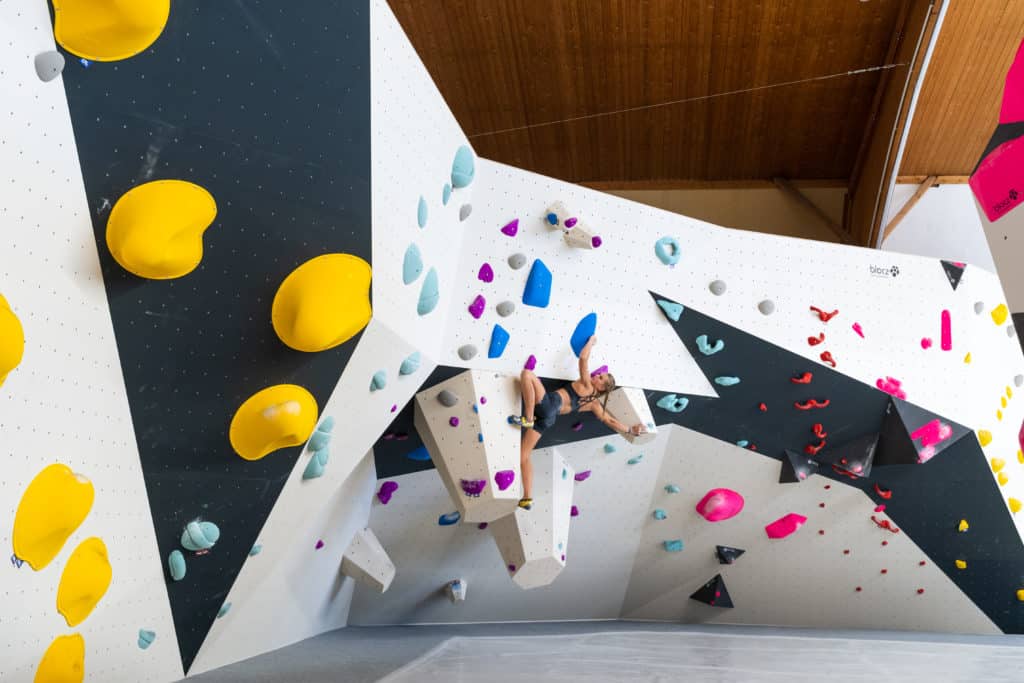
What do I need to start bouldering as a beginner?
According to Nick from urban apes, bouldering is the perfect sport for urban athletes who don’t want to haul a lot of equipment around. Bouldering on the wall only requires climbing shoes and chalk. Climbing shoes and chalk can usually be rented in all bouldering gyms at a small extra cost.
1. Shoes for bouldering or climbing
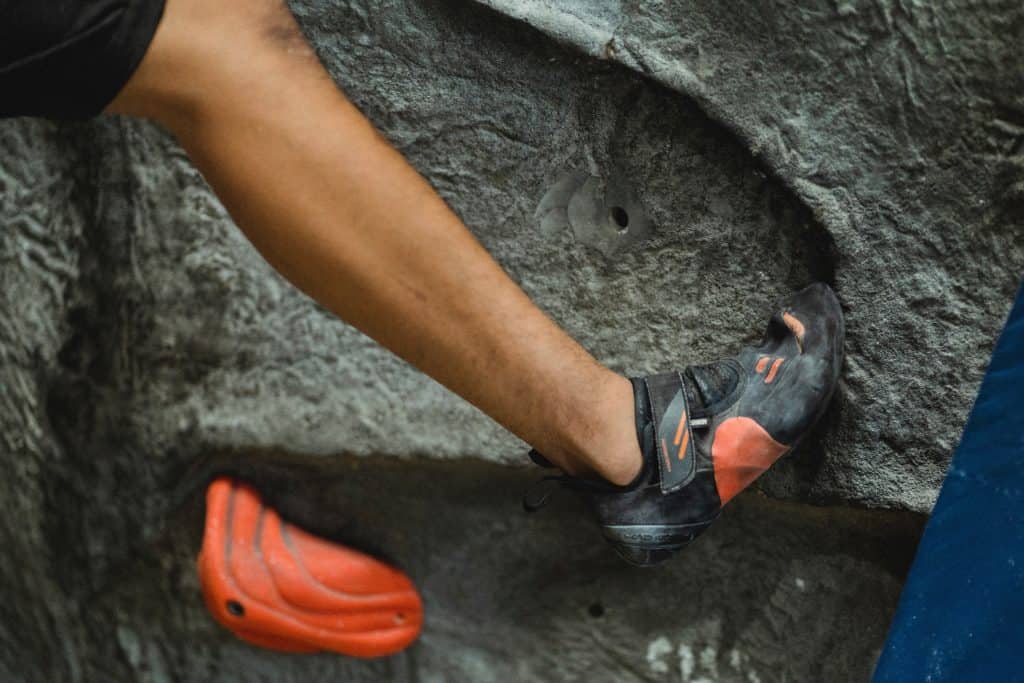
Nick explains that bouldering requires climbing shoes with a specially hardened sole and tread. As a beginner, you may quickly feel overwhelmed when having to choose which bouldering shoes to buy – but don’t worry: If you want to get a feel for the shoes first, you can rent climbing shoes at the bouldering gym and see if you really enjoy bouldering before investing in new shoes. Then a beginner’s shoe is recommended in any event. It’s a little more comfortable to wear because it has less pretension, is symmetrical, and the sole provides support. It’s best to test various shoes and to get advice.
2. Chalk
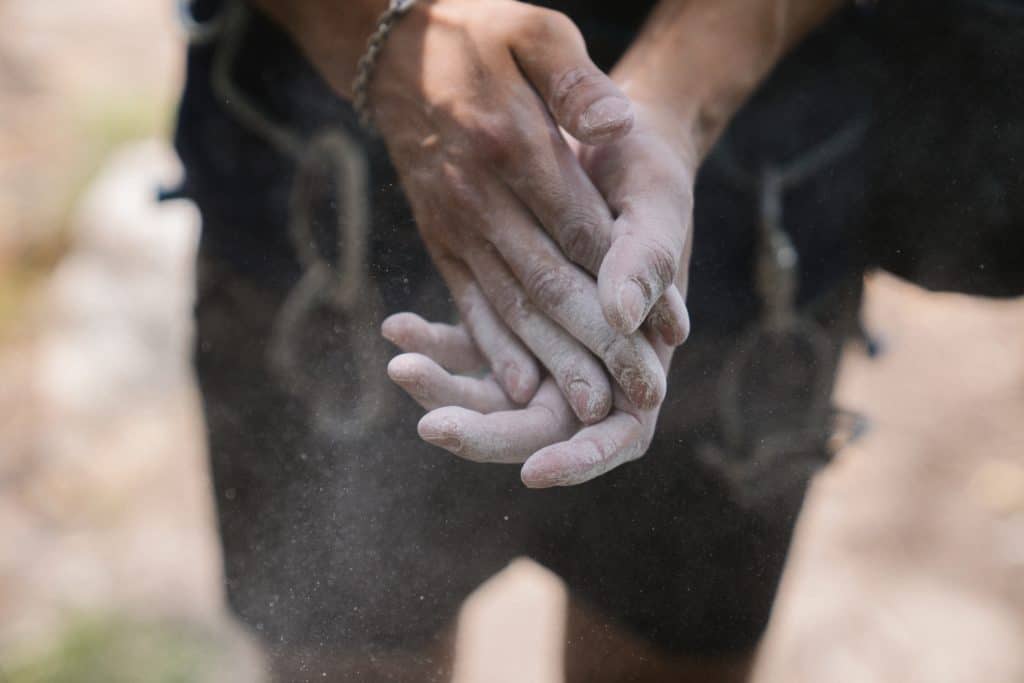
For a good grip on the wall not only with your feet, but also with your hands, chalk is recommended for climbing and bouldering indoors. Chalk, also known as magnesium carbonate, prevents having sweaty hands when bouldering and thus provides a more secure grip. Chalk can be found in various forms: as a powder, as a pressed chalk ball or as a liquid (liquid chalk). No matter which of these three forms you choose – over time you will find out what your preference is. For the beginning, however, you start with the cheaper option: powder.
3. Chalk bags

If you are now wondering what would be the best way to carry the powder to the hall – don’t worry! Of course, you don’t have to just carry it in your hands. There are chalk bags for storage. When buying one, you can’t go wrong. Most importantly, the bag should have a wide opening for reaching inside (depending on the size of your hand), a fastener, and be made of dirt and moisture repellent material. Usually all chalk bags are made that way. Liquid chalk, by the way, is transported in bottles.
What are the basics of bouldering?
Bouldering is a perfect whole-body workout that targets a variety of muscle groups, says expert Nick. Most importantly, the sport requires thinking, because “reading routes” is a key component. This will help you quickly clear your mind from other thoughts. Focusing on the wall is most important to be successful in bouldering.

Beginners can quickly be discouraged when they fall out of a bouldering route for the first time. Falling, however, is a completely normal process and part of the bouldering experience. We all started small and only make progress when we face our previous limits. The mats are soft and everyone can learn basic techniques in classes, also with the help of coaches.
Bouldering requires not only strength, but above all technique, agility and coordination. But before giving you tips on climbing, let’s take a look at the key rules.
What are the rules when bouldering in the hall?
According to Nick, the most important rule is to be considerate in general – to others and yourself. Wear the sports outfit you feel comfortable with. You don’t have to prove anything to anybody – whether female, trans, non-binary, queer or male, young or old. Everyone starts at a different level and has different goals. This is exactly why there are various levels of difficulty, so there is something for every level of experience.
Before starting at a boulder, make sure to check the route beforehand and that the fall area is clear. If this is the case, then you can start. To set off with bouldering, begin with both hands on the marked starting holds. Leave your hands on the starting holds until both feet have cleared the mat. Sometimes two holds are there as a start, sometimes only one.
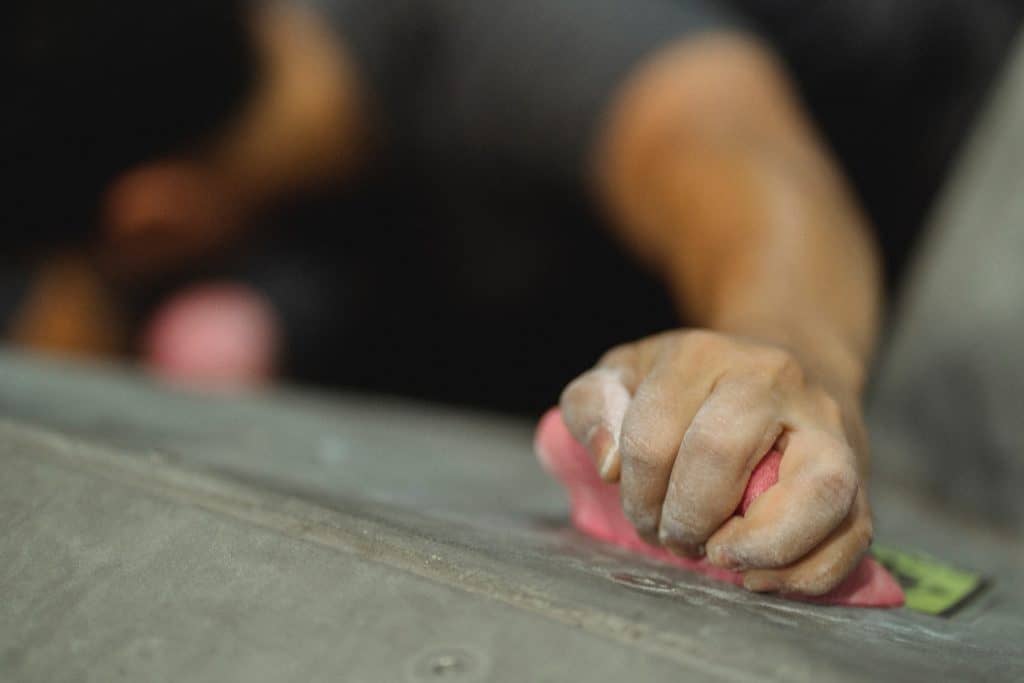
From start to top, you may only use the holds and steps of one color or degree of difficulty. Parts of the wall structure, such as edges and volumes, may be used for support. As a beginner, one tends to forget them. Try to keep them in mind when planning your route. The end of the boulder is either the top hold, which you need to touch with both hands, or you can climb beyond the last hold. Jumping off is tempting, but it is definitely healthier and more relaxing to climb down.
Please see below the most important rules in brief:
- Before you start, check the route and the space for falling
- Start the boulder with both hands on the marked starting holds. Leave your hands on the starting holds until both feet have left the mat
- From start to top, only the holds and steps of one color (of the same level of difficulty) may be used
- Parts of the wall structure, such as edges and volumes may be used for support
- The end of the boulder is either the top hold that you need to touch with both hands, or you can climb beyond the last hold
- Climb down, don’t jump off
- Be considerate – of yourself and others
What are the difficulty levels of bouldering?
If you’ve been to a bouldering hall before, you may have noticed the different colors – yellow, green, blue, red and some more. As described above, you climb a route from starting to top hold within one color scheme. But there are differences from hall to hall. Some bouldering halls work with the level system, others with the colors themselves. But what does this mean exactly?
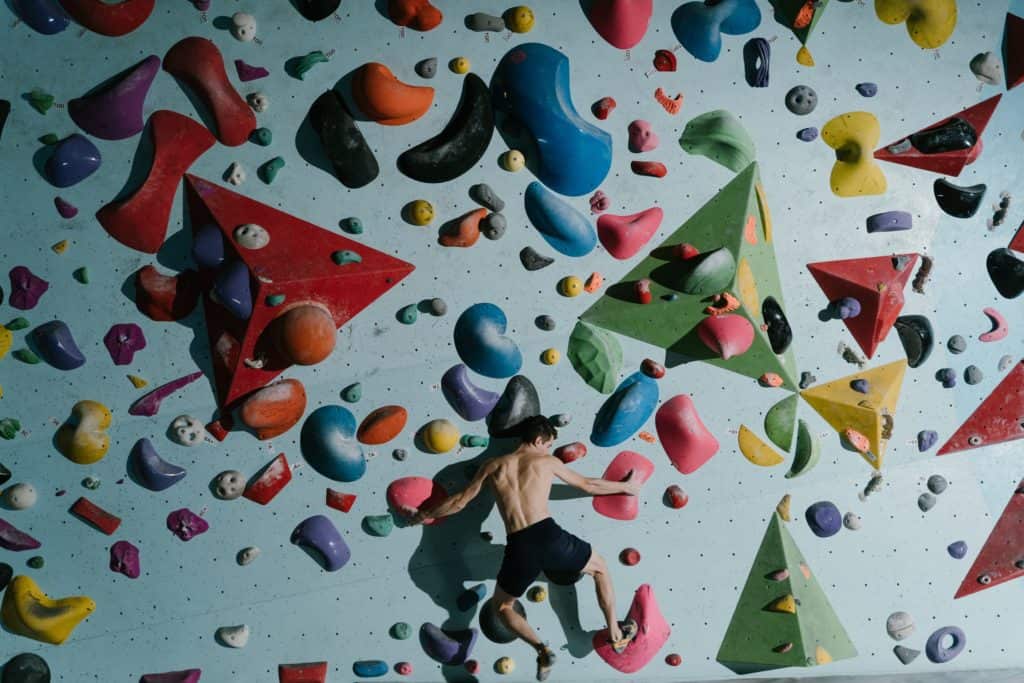
When bouldering in the hall, it is common that the difficulty of the boulder is based on a color scale. In some climbing halls, the different colors indicate the difficulty levels. For example, the yellow and blue routes are for beginners, and green for advanced climbers. You can simply follow the color of the holds and footholds. For an overview, there is usually a poster explaining the different difficulty levels of the colors.
Other halls, like the ones from urban apes, use the level system. You can also see different colors that you can climb, but they do not directly indicate the difficulty level. “We have an easy-to-understand level system from one to eight. Level one boulders are easy and level eight boulders are the most difficult challenges. Basically, the sport is suitable for all who are not subject to any significant physical limitations”, explains Nick.
Tips for bouldering beginners
To make your start easier, we have compiled four tips for you.
1. Look for personal bouldering projects
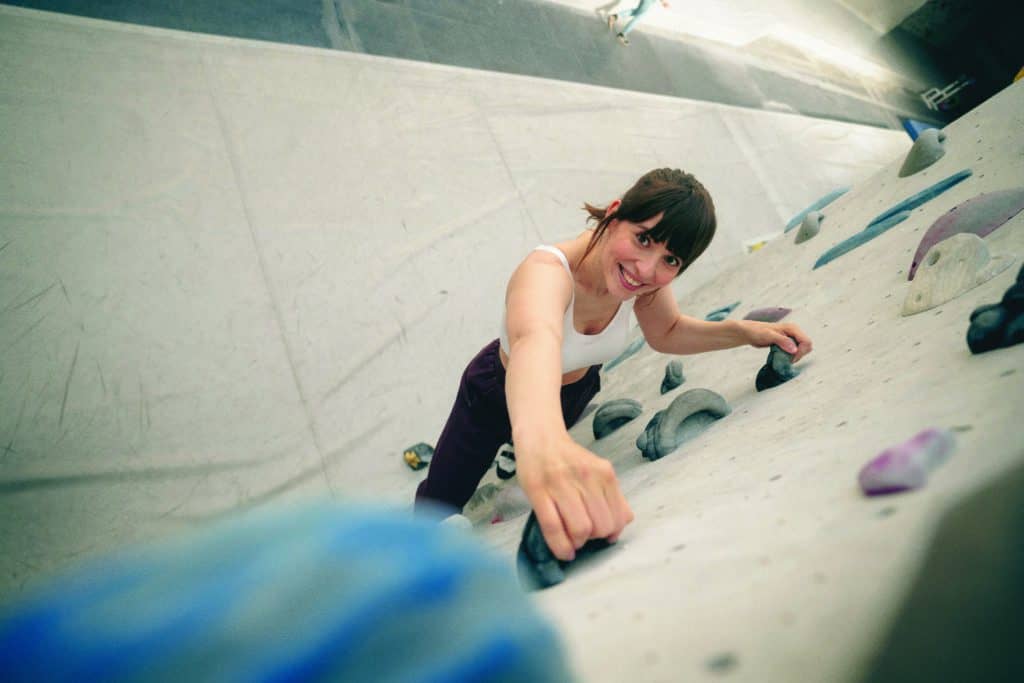
Nick’s first tip: Climb bouldering routes you feel comfortable in. Don’t try to prove anything to anybody – we all have our own pace. This doesn’t mean you shouldn’t challenge yourself – it means you shouldn’t get discouraged so quickly if you can’t reach the top of a boulder immediately. Make a boulder your project. If you have problems with certain holds, footholds, angles or degrees of steepness, target those weaknesses specifically. Often only our own prejudices about ourselves (“I’ll never make it anyway!”) are our biggest opponent. Get rid of them and allow yourself to get to know yourself anew. Professional rock climber Stephan Vogt also confirms: “Don’t be deterred! Don’t just try boulders that you can climb quickly, but go for those that may seem too hard at first. That’s how I got better. Sometimes it’s better not to shy away from difficulty!”
2. Train your basic skills and movement patterns

It is probably logical, but the best training for your bouldering muscles is bouldering itself, says Nick. Don’t simply jump on a fingerboard and thus overload your muscles – practice basic skills and movement patterns first. How quickly you reach the next level depends entirely on how much you boulder. You can achieve success within a few days. Those who want to learn from a professional coach can also learn tips and tricks in a class.
3. Use your leg strength, foot tip, hip and leg flexor
In particular as a beginner, you are often tempted to pull with your arms – but that takes a lot of strength. The legs are usually much stronger than the arms. Use this power and thus save energy for more difficult passages. If you use the tip of your shoe for the footholds and lower the heel a little, you increase your grip and save energy. It is also easier to make a foot change like this.

Nick also advises that in addition to your hands and feet, the hips are especially relevant. Use momentum and turns to move in a power-saving manner and in a specific direction. If your center of gravity is close to the wall, you in turn lighten the load on your arms. If you want to try out something different, the heel hook is recommended. Hook your heel into the hold and use your leg flexor. Again, you’ll relieve pressure on your arms and stabilize your body.
4. Read routes and experiment with your position
As Nick mentioned above, thinking and “reading the routes” are an important part of the sport. The more experience you gain, the easier it will be to work out your routes. The beauty of bouldering is that you actually never have to solve a route on your own – it often happens quite naturally that you start a conversation with other climbers and find the solution together. In addition to reading the routes, it can help to experiment with your body position. There are various ways to climb a route. Try it!
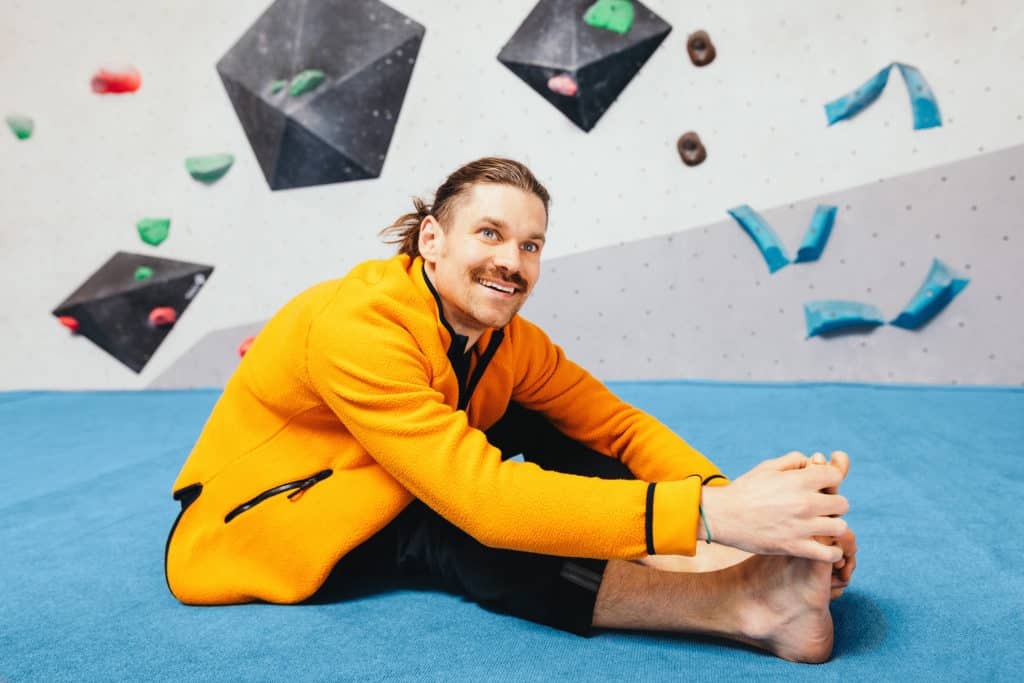
What makes bouldering so special?
It is really incredible how the sport of bouldering has developed over the past few years. So many new bouldering halls have been established in just a few years. You can tell that bouldering has become a real trend. Stephan Vogt tells us what makes this sport so special for him.
“When I started bouldering, many of my friends didn’t even know the sport existed. Now almost all of them are bouldering themselves. No wonder: it is an incredibly versatile sport. Each hall has its own style, which provides for even more variety if you go to different halls now and then. I also love the community and the wonderful feeling of working on a bouldering problem with friends and eventually solving it.”

Where can I go climbing and bouldering as a beginner?
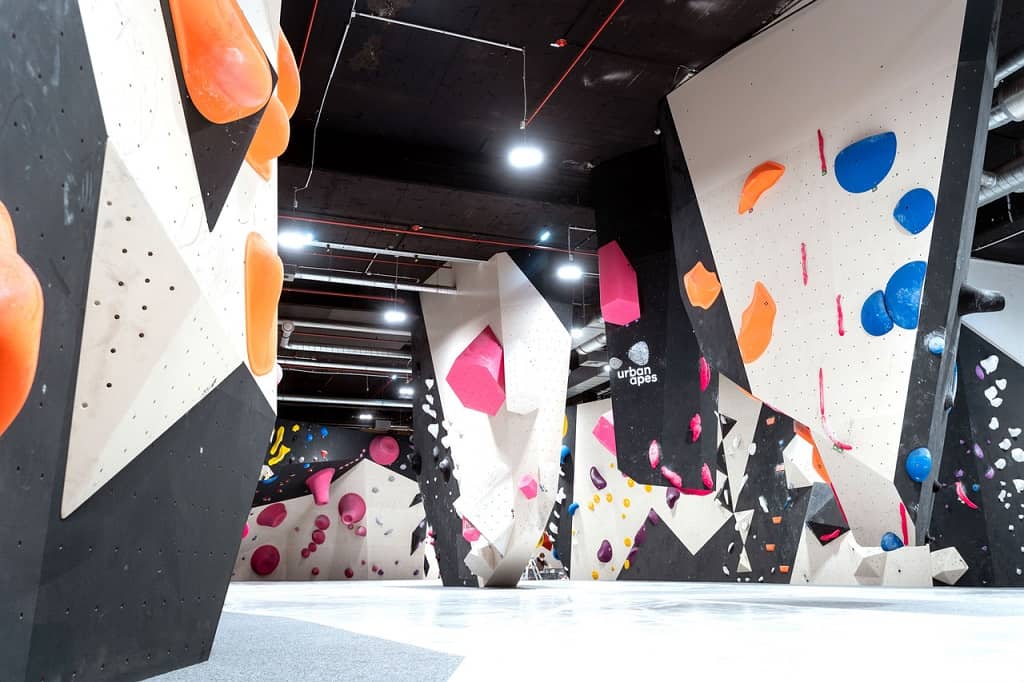
If you want to go bouldering, a bouldering gym is recommended. Climbing gyms often also have bouldering areas, but bouldering halls are actively designed for climbing without a rope. At Urban Sports Club, you have a large selection of bouldering partners all over Germany and Europe. Try urban apes Boulderhallen in Hamburg. In Berlin, you can climb at bright site or at Basement Boulderstudio. Munich residents can climb to great heights at einstein Boulderhalle. In Cologne, the Stuntwerk is a good alternative.
What is your favorite bouldering gym? Do you have any other tips for bouldering beginners?



Comments